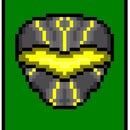Introduction: Making a Knife
This instructable will teach you how to make a decorative or a work knife. Please take caution when you build and use it.
Step 1: Tools
A furnace that will get metal hot enough to make it red, possibly orange. The hotter the metal the better it moves. However if you get it too hot it dents easy and if it is too cold it dents and cracks easy. So keep it a nice cherry red coulee when pounding and heating constantly
You also need an assortment of ball peen hammers and a short handled 3 lb. sledge
An anvil or railroad track that is of hard steel.
Wood or antler for the handle
Brass rod about 2-3 eighth wide
A drill and drill bit the size of the brass rod
And some matches or lighter along with file for your fire.
Step 2: Choose Your Metal Hardness
You want a metal that will bend somewhat easy but will not break under hard pressure. As shown above the metal piece in the center would be the best choice because you can't bend or break it by hand. Keep in mind that this knife will not be as good as Damascus steel. The best type steel for making knives consists of a very low carbon count. As you choose your steel and get your tools together you should start your fire and get some Coles in the furnace before you start.
Step 3: Pounding
Once you find that the flame of your fire is steadily burning and that there is a coal bed, place your metal in the fire were the coals are the reddest. Use a fan, a blow drier or some sort of billow to blow air into your fire to make it burn hotter. Continue blowing air i to the fire for say 5-15 minutes casually checking for redness in the blade as you go. Move the blade gets red pound the metal until the redness goes away.
It is best to use the sledge when you start until it gets real thin say 2-3 8th thick. Once its gets this way after many reheats use the ball peeks to thin out the blade. Be cautious that you don't fold over the tip of your knife.If you do just buff or grind it off. Male sure that when you form it make a square end one the knife for when you insert it into the knife handle.
Step 4: The Handle
Take the handle of your choosing, mine was a deer antler and cut it to the right length of your hand. Once it is cut decide which end it to have the blade in it and drill a hole as wide and long as the flat square part of your knife. After you check to make sure it fits take the drill and drill through the handle and the knife so that the holes line up in the handle.
Step 5: Connecting Blade to Handle
Take the brass rod and thread it through the hole you have just made and cut it off a little longer than the hole itself. You do this to make sure when you peen the brass it makes a good peen and not a cracked or indented one. Once both are cut put them in the holes and hit one side of them with the rounded part of the ball peen hammer. Do only one side at a time while keeping the other sideline the anvil. Once it is peeked you may file any unwanted bumps out of the peen.
Step 6: Filing All Over
Once the blade is in the handle, clamp the handle in a vice and file away at the back and blade until there are no notches from hammering the metal out. Once the back of the knife is smooth file at the side and edge of the blade to give it a shine and equal flared sharpness on each side. Filing the sides of the knife is optional it just makes it look nicer.
Step 7: Done
Your almost done. Wipe the whole knife down with oil so that it doesn't dry up or rust and set it somewhere until you get time to see an instructable on sheath sewing. Unless you like to see it without one.
A word of advise, please do everything with the forge in a well ventilated area no thats not your basement.
Some images were taken from the Internet because i didn't have them. Thanks internet explorer. Please leave a comment if you have any Q's or are confused.













